Categories > Guides and Tips

The Changing Face of Canada’s Divorce Statistics: Trends and Insights
- Divorce Trends and Statistics in Canada: Key Takeaways
- How much does a divorce cost in Canada?
- Understanding Divorce Trends in Canada
- Number of Divorced People in Canada
- Number of Finalized Divorces in Canada
- Downward Trend of Divorce in Canada
- Divorce Rates Comparison between Canada and Other Countries
- Demographic Breakdown of Divorce in Canada
- Divorce Rates in Canadian Provinces and Territories
- Canadian Divorce Rates by Age Group
- Canadian Divorce Rates by Gender
- Implications of Declining Marriage Rates on Divorce Rates in Canada
- Life After Divorce in Canada: New Relationships and Family Structures
- References
Divorce Trends and Statistics in Canada: Key Takeaways
| • The divorce rate in Canada fell to 1.1 per 1,000 individuals in 2021, down from 1.7 in 2000, driven by the rise in common-law unions and delayed marriages (Statistics Canada, 2021). • Statistics Canada show that Canadian courts finalized 42,933 divorces in 2020, a sharp 25% drop from 56,937 in 2019, marking the largest annual decline since the Divorce Act was introduced in 1968. • Women had a higher divorce rate than men in 2017, at 8.6 divorces per 1,000 married individuals compared to 8.4 for men, reflecting gender-based differences in divorce initiation (Statistics Canada, 2017). • Statistics Canada reports that in 2021, 64.6% of Canadian census families were married couples, while 19% were common-law couples—a record high. This shift in family structures may be a contributing factor to the observed decline in divorce rates. • Statistics Canada found that divorced individuals aged 35 to 64 typically take an average of 4.5 years (men) and 4.8 years (women) to form new relationships. • According to estimates from Spectrum Family Law, an uncontested divorce in Canada costs an average of $1,740. Meanwhile, contested divorces can cost up to $23,730, illustrating the financial burden of separation. |
Marriage and family structures in Canada are changing significantly.
Statistics Canada reports that the traditional nuclear family is no longer the most common family structure. Many Canadians now live in common-law unions or have gone through multiple divorces or separations.
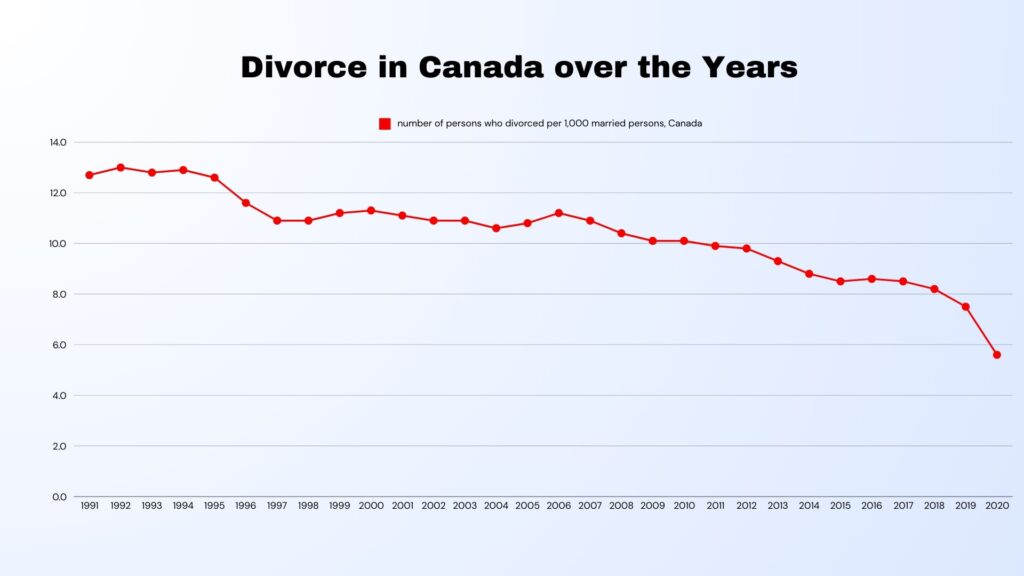
Divorce rates in Canada have been steadily declining since the early 1990s. From 12.7 divorces per 1,000 married people in 1991, the rate fell to 7.5 per 1,000 in 2019 and further to 5.6 per 1,000 in 2020.
The most dramatic decline was observed between 2019 and 2020, likely due to pandemic-related court closures and economic disruptions (Statistics Canada, 2021).
The decline in divorce rates coincides with a decrease in marriage rates, with more couples choosing common-law partnerships. These trends show how relationships and family dynamics in Canada are evolving over time.
How much does a divorce cost in Canada?
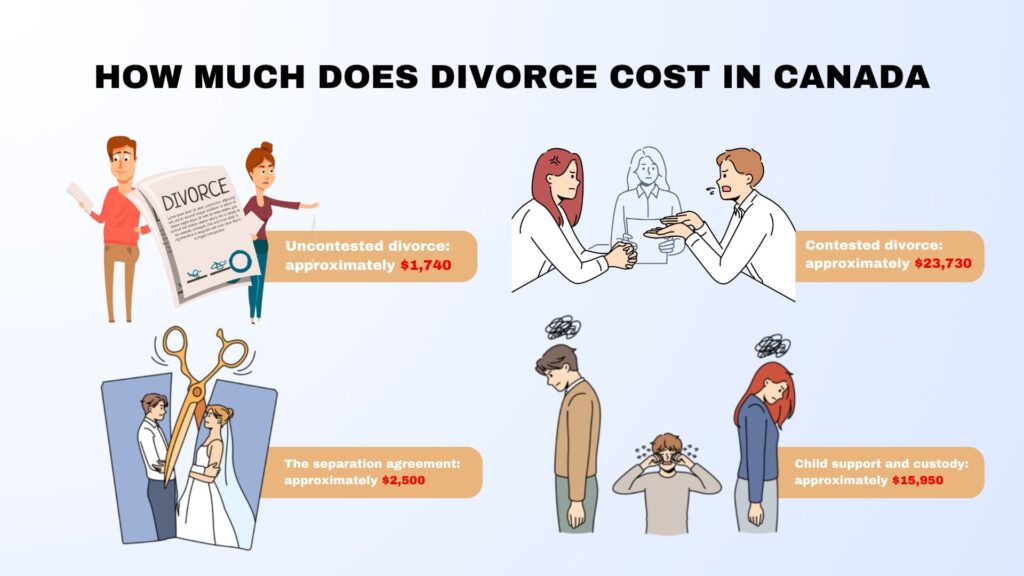
In general, an uncontested divorce costs around $1,740 on average, while contested divorces can rise to $23,730. High-conflict cases can even reach hundreds of thousands of dollars (Spectrum Family Law).
Other costs include separation agreements, averaging $2,500, and child custody disputes, which can cost up to $15,950. Additional fees for court filings and bailiff services also add up.
Lawyer fees vary by province and depend on the case’s complexity and the lawyer’s experience.
Many couples opt for mediation or collaborative divorce to reduce costs. Mediation fees range from $1,000 to $5,000. These methods are becoming more popular for reducing financial and emotional strain during divorce.
Understanding Divorce Trends in Canada
Number of Divorced People in Canada

While divorce rates have decreased the number of divorced individuals continues to rise in Canada. Statistics Canada reported that in 2022, approximately 2.78 million Canadians were divorced and had not remarried, including those in common-law partnerships.
This represents a 2.53% increase from 2020, reflecting a gradual but consistent upward trend over decades. This growth mirrors Canada’s rising population. In 2000, there were about 1.88 million divorced individuals.
By 2022, this number had grown by nearly 48%, outpacing the overall population increase during the same period. Comparatively, the number of married individuals rose by only 6.39% between 2018 and 2022.
Number of Finalized Divorces in Canada

The number of divorces granted annually in Canada has fluctuated over the decades.
According to Statistics Canada, Canadian courts finalized 42,933 divorces in 2020, marking a sharp 25% decline from 56,937 in 2019—the largest year-over-year drop since the Divorce Act was enacted in 1968.
This decline was likely influenced by the COVID-19 pandemic. Court closures and backlogs made it difficult for couples to finalize divorce proceedings.
Furthermore, divorce requires a one-year separation period, meaning couples filing in 2020 would have started their separation in 2019. The uncertainty of the pandemic likely caused many couples to delay legal proceedings.
Downward Trend of Divorce in Canada
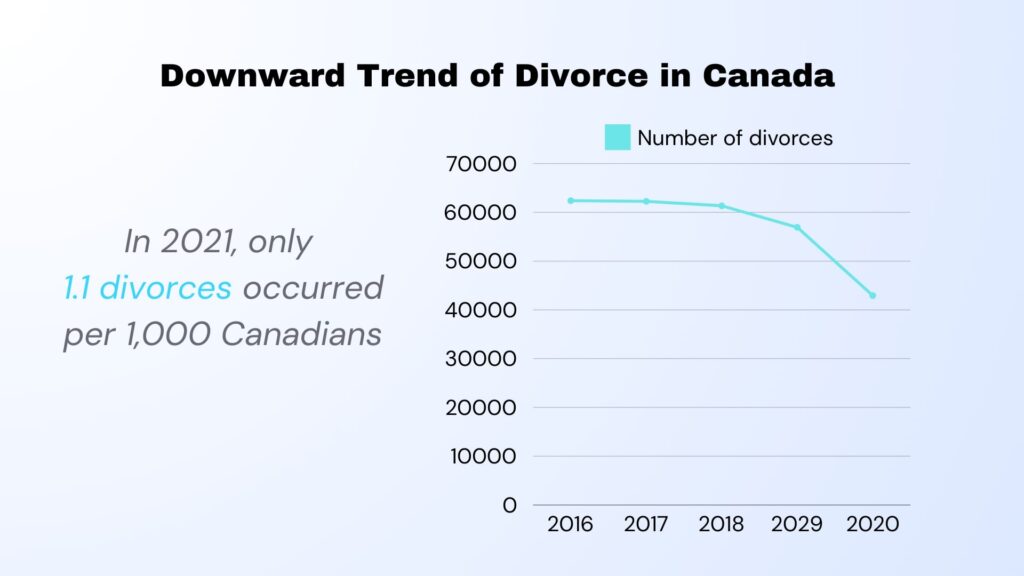
Reports from Statistics Canada show that divorce rates in Canada have dropped recently due to social and economic changes. In 2021, there were 1.1 divorces per 1,000 Canadians, which went down from 1.7 in 2000.
More people are choosing common-law relationships, which don’t need legal processes to end. By 2021, 23% of Canadian couples were in common-law relationships, the highest among G7 countries (Statistics Canada, 2021).
People are also marrying later. In 2021, the average age for first marriage was 31.1 years for men and 29.4 years for women, up from 27.4 and 25.7 in 2000.
Marrying later often leads to more financial and emotional stability, which lowers divorce rates.
Divorce Rates Comparison between Canada and Other Countries
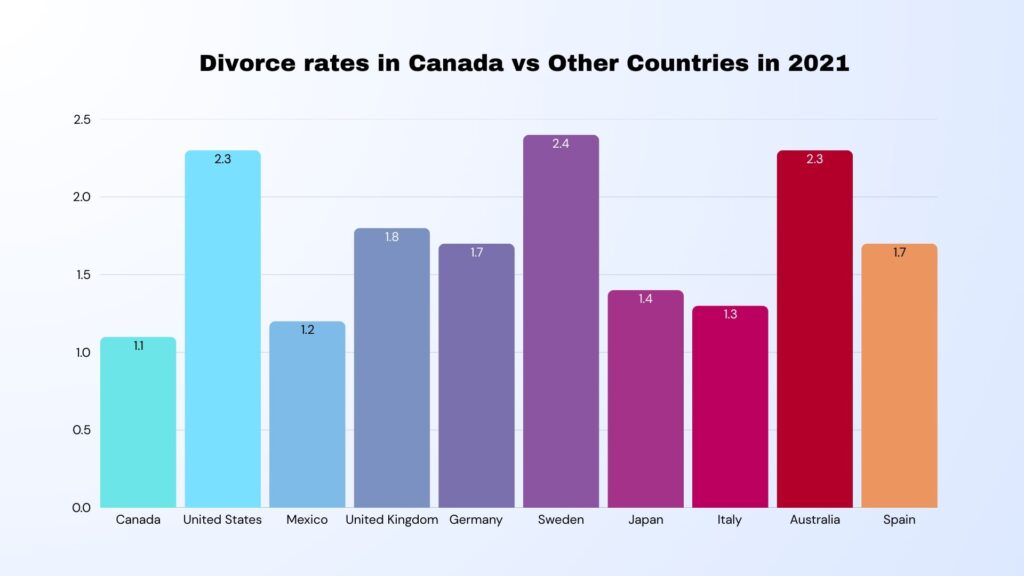
| Country | Divorce rate (Per 1,000 Population) |
| Canada | 1.1 |
| United States | 2.3 |
| Mexico | 1.2 |
| United Kingdom | 1.8 |
| Germany | 1.7 |
| Sweden | 2.4 |
| Japan | 1.4 |
| Italy | 1.3 |
| Australia | 2.3 |
| Spain | 1.7 |
Canada has a relatively low divorce rate compared to other developed countries. In 2021, the country had 1.1 divorces for every 1,000 people. This contrasts with higher rates in countries like the United States (2.3 per 1,000) and Sweden (2.3 per 1,000) (United Nations Statistics Division’s Demographic Yearbook, 2023).
This lower figure may be partially attributed to the high prevalence of common-law partnerships in Canada. These unions, while legally recognized, are not formally registered as marriages, consequently not reflected in official divorce statistics.
Cultural nuances and legal frameworks also play a role. For example, in the U.S., divorce is more accessible in many states. In contrast, Canadian law mandates a mandatory one-year separation period before a divorce can be finalized, potentially acting as a deterrent for some couples
Demographic Breakdown of Divorce in Canada
Divorce Rates in Canadian Provinces and Territories

Statistics Canada reports that divorce rates in Canada vary significantly across provinces and territories. Yukon reports the highest rate at 12.8 divorces per 1,000 married individuals, followed by Alberta with 9.7 per 1,000.
In comparison, Newfoundland and Labrador has the lowest rate at 6.2 per 1,000.
Ontario experienced a sharp decline, with rates dropping from 7.1 divorces per 1,000 in 2019 to 4.4 in 2020, a trend likely influenced by pandemic-related disruptions.
These variations highlight the impact of differing population demographics, cultural attitudes, and economic conditions.
For instance, Yukon’s higher rates may be linked to its smaller population and unique social dynamics, while Newfoundland and Labrador’s lower rates reflect more traditional family structures.
Canadian Divorce Rates by Age Group
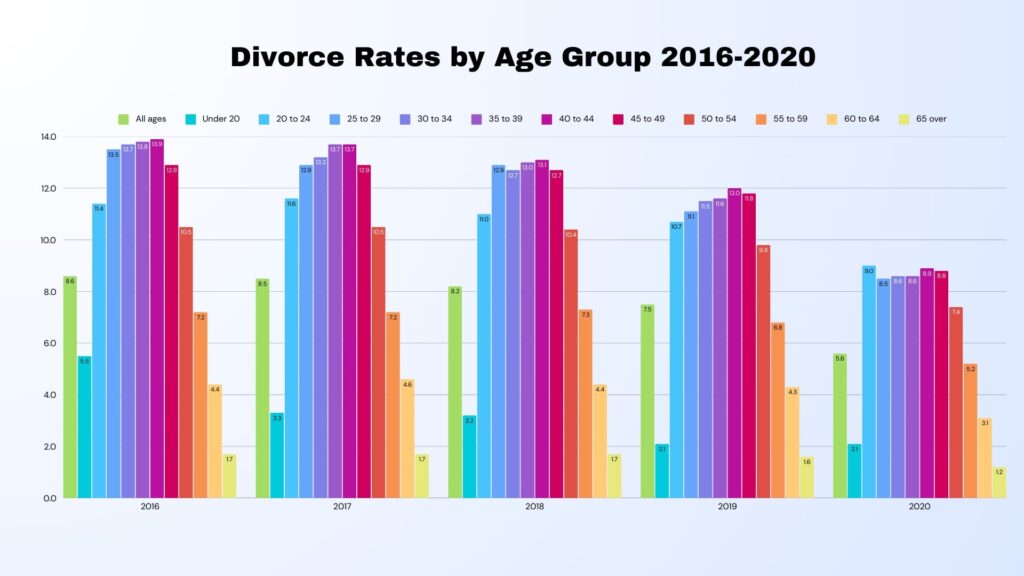
Statistics Canada shows that divorce rates in Canada differ significantly by age group, with individuals in their 40s facing the highest rates.
Between 2016 and 2020, people aged 40 to 44 accounted for 28% of all divorces. However, divorce rates for this group dropped by 36% during this period, aligning with an overall decline in divorce rates across all age groups.
On the flip side, younger adults, particularly those in their early 20s, have the lowest divorce rates. This is largely due to fewer marriages in this age group, as many young adults are prioritizing education, career growth, and financial stability over marriage.
The phenomenon of “grey divorce,” involving individuals aged 50 and older, is steadily increasing. Divorce rates for individuals aged 50 to 64 have declined at a slower pace, reflecting a shift in societal norms and a willingness to prioritize personal fulfillment later in life.
Factors contributing to grey divorce include higher life expectancies, second marriages, and evolving relationship dynamics.
Statistics Canada also reports that for those over 65, divorce rates increased by 3% from 2019 to 2022, a trend that underscores the changing landscape of relationships in later life.
Canadian Divorce Rates by Gender
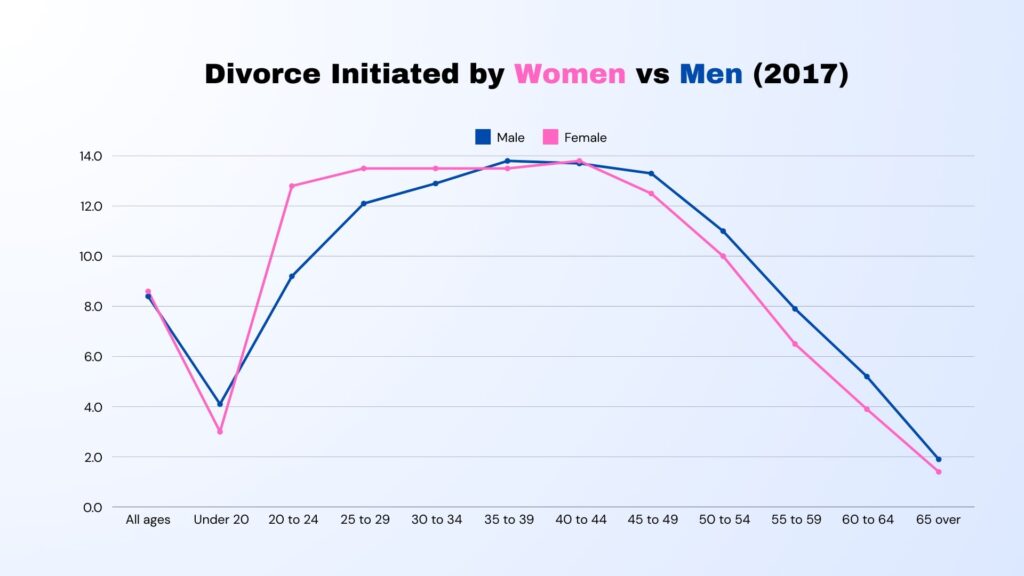
Gender differences in divorce rates reveal interesting patterns across age groups in Canada. In 2017, the divorce rate for women was slightly higher, at 8.6 divorces per 1,000 married individuals compared to 8.4 for men (Statistics Canada, 2017).
This difference is influenced by the tendency of women in younger age groups to initiate divorce more often than men, often due to dissatisfaction or incompatibility.
Conversely, men are more likely to initiate divorces later in life, particularly after retirement or when pursuing new relationships.
In the age group of 50 to 64, 52% of divorces were initiated by men in 2020 (Statistics Canada, 2021). This reflects shifting priorities and personal circumstances in different life stages.
The introduction of Canada’s no-fault divorce system in 1968 helped balance the gender disparity in divorce laws, ensuring equal access to separation regardless of fault or reason.
Implications of Declining Marriage Rates on Divorce Rates in Canada
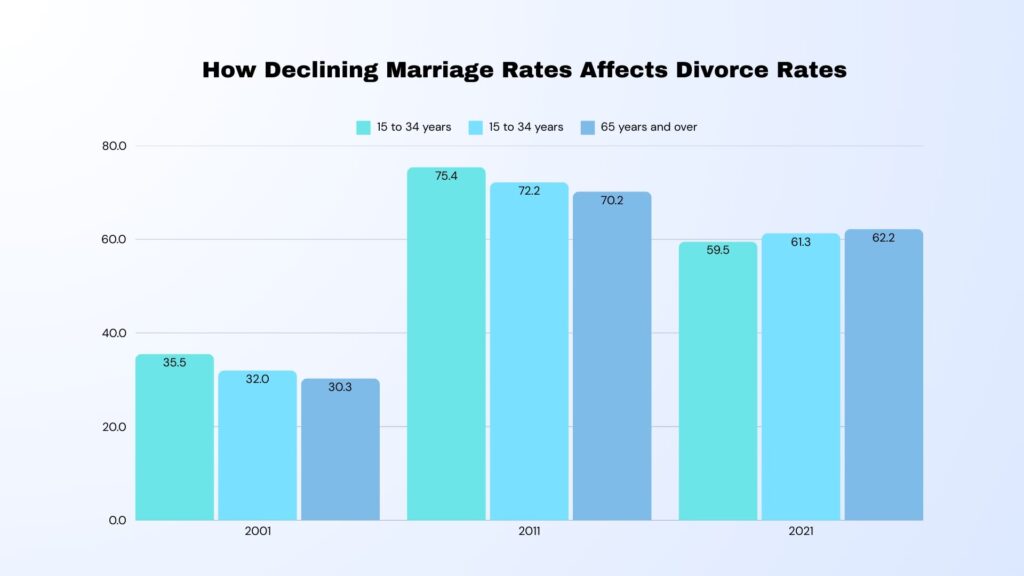
According to Statistics Canada, marriage rates in Canada have been steadily declining, which has directly influenced overall divorce rates. By 2021, only 64.6% of census families were married couples, marking a significant drop from previous decades.
At the same time, 19% of couples were in common-law unions—a record high—and 16.4% were single-parent families.
This decline in marriage rates is particularly noticeable among young adults, with 35.1% of those aged 20 to 34 still living with their parents, a trend driven by economic pressures and delayed life milestones.
Fewer marriages naturally lead to fewer divorces, as common-law partnerships, which now account for 23% of Canadian couples, do not require formal legal proceedings to end.
Additionally, the evolving makeup of Canadian households is shaping relationship dynamics and family structures. For instance, there were 95,435 same-gender couples and 32,205 transgender or non-binary couples in 2021.
These shifts contribute to more diverse family arrangements and lower formal marriage rates, influencing divorce trends.
Life After Divorce in Canada: New Relationships and Family Structures
Image idea:
- An infographic titled “How Long It Takes to Start New Relationships After Divorce”
- Emphasize each line in the infographic, use vector images to represent this 3 points:
- “Data from 2017 shows that men aged 35 to 64 took an average of 4.5 years, and women 4.8 years, to start new relationships after divorce.”
- “By 2020, 26% of people in second or later unions were remarried or in new common-law partnerships.”
- “Older adults often chose “living apart together” (LAT) arrangements for companionship without formal commitments.”
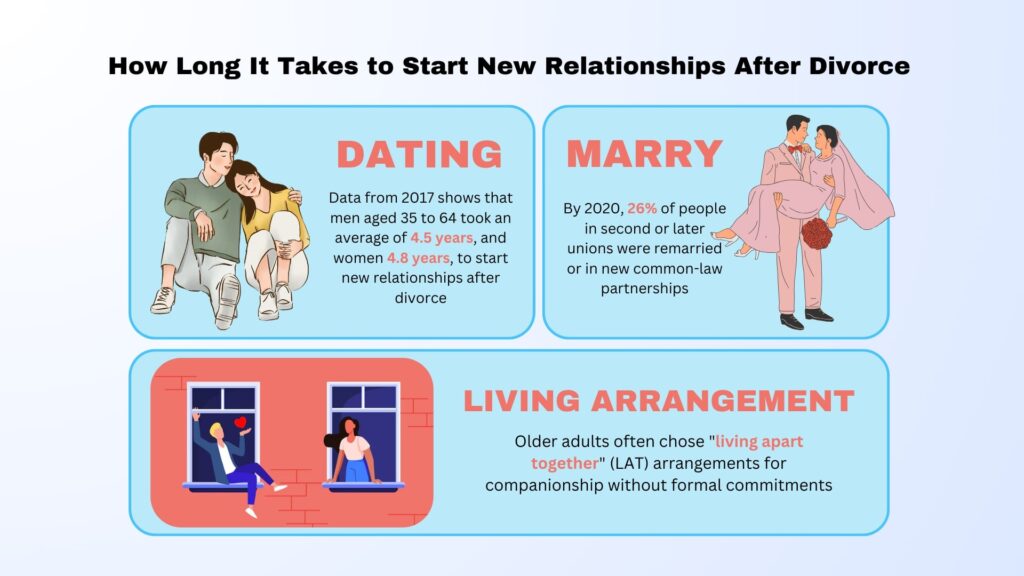
Data from 2017 shows that men aged 35 to 64 took an average of 4.5 years, and women 4.8 years, to start new relationships after divorce. This time was needed to heal emotionally, recover financially, and manage co-parenting (Statistics Canada, 2017).
By 2020, 26% of people in second or later unions were remarried or in new common-law partnerships. Many preferred common-law relationships for their flexibility and fewer legal complications.
Older adults often chose “living apart together” (LAT) arrangements for companionship without formal commitments.
These trends highlight Canadians’ resilience in forming new relationships despite financial and family challenges.
References
- Divorce Frequently asked Questions – Spectrum Family Law. (2024, December 4). Spectrum Family Law. https://www.spectrumfamilylaw.ca/alberta-divorce-frequently-asked-questions/
- Government of Canada, Department of Justice, Electronic Communications. (2023, July 10). 4. Findings. https://www.justice.gc.ca/eng/rp-pr/cp-pm/eval/rep-rap/2023/cfjf-fcjf/p4.html#:~:text=Divorce%20rates%20dropped%20over%20the,by%20year%2C%20is%20as%20follows:
- Government of Canada, Statistics Canada. (2019, May 15). The Daily — Family matters: New relationships after separation or divorce. https://www150.statcan.gc.ca/n1/daily-quotidien/190515/dq190515c-eng.htm
- Government Of Canada, Statistics Canada. (2022, March 9). Decline in divorce rates in all the provinces and territories in the last decades. https://www150.statcan.gc.ca/n1/daily-quotidien/220309/t002a-eng.htm
- Government of Canada, Statistics Canada. (2022a, March 9). Mean age and median age at divorce and at marriage, for persons who divorced in a given year, by sex or gender. https://www150.statcan.gc.ca/t1/tbl1/en/tv.action?pid=3910005201
- Government of Canada, Statistics Canada. (2022b, March 9). Number of persons who divorced in a given year and divorce rate per 1,000 married persons, by age group and sex or gender. https://www150.statcan.gc.ca/t1/tbl1/en/tv.action?pid=3910005301&pickMembers%5B0%5D=1.1&pickMembers%5B1%5D=2.3&pickMembers%5B2%5D=4.2&cubeTimeFrame.startYear=2016&cubeTimeFrame.endYear=2020&referencePeriods=20160101%2C20200101
- Government of Canada, Statistics Canada. (2022c, March 9). The Daily — A fifty-year look at divorces in Canada, 1970 to 2020. https://www150.statcan.gc.ca/n1/daily-quotidien/220309/dq220309a-eng.htm
- Government of Canada, Statistics Canada. (2022d, July 13). The Daily — State of the union: Canada leads the G7 with nearly one-quarter of couples living common law, driven by Quebec. https://www150.statcan.gc.ca/n1/daily-quotidien/220713/dq220713b-eng.htm?HPA=1
- Government of Canada, Statistics Canada. (2022e, November 9). Estimates of population as of July 1st, by marital status or legal marital status, age and sex. https://www150.statcan.gc.ca/t1/tbl1/en/tv.action?pid=1710006001
- Government of Canada, Statistics Canada. (2022f, November 14). Number of divorces and divorce indicators. https://www150.statcan.gc.ca/t1/tbl1/en/tv.action?pid=3910005101
- Government of Canada, Statistics Canada. (2023, October 4). Focus on Geography Series, 2021 Census – Canada. https://www12.statcan.gc.ca/census-recensement/2021/as-sa/fogs-spg/page.cfm?lang=E&topic=4&dguid=2021A000011124
- Nussbaum Family Law. (2024, November 28). Divorce stats in Canada. Nussbaum Law. https://nussbaumlaw.ca/divorce-stats-in-canada/
- Statistics Canada. (2022). A fifty-year look at divorces in Canada, 1970 to 2020. In The Daily [Report]. https://www150.statcan.gc.ca/n1/en/daily-quotidien/220309/dq220309a-eng.pdf?st=QxzEVqmg






